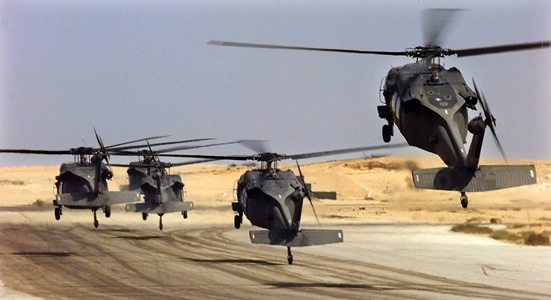 |
| Black helicopters |
The “black helicopter” came to public prominence as part of the conspiracy theories of a New World Order, which were much reported upon as the core belief of the U.S. militia movement that rapidly arose in the western United States in the early 1990s.
Stories of unidentified black helicopters seen flying over rural areas and accounts of menacing encounters with the craft and their occupants were soon being incorporated into the unfolding narrative of a monster plot involving the federal government and the imminent takeover of the United States by the United Nations.
The conspiracy website Parascope invited people to report sightings of black helicopters; a typical example (from “Nighthawk” dated August 1996) read: “Our Texas Air Guard flys [sic] very dark green copters with no markings on them and they look black from a distance. I believe they are up to no good. Why are they unmarked? They also have some in Montgomery county to the North of here which used Infer-red scans to search for missing people among other things.”
  |
The alleged sightings were numerous enough by 1994 that the popular conspiracy author Jim Keith compiled a book called Black Helicopters over America; his thesis was revealed by its subtitle: Strikeforce for the New World Order. Before long, the black helicopter became synonymous with crackpot conspiracy beliefs, and sightings were familiar enough to be parodied in satirical TV shows such as South Park and King of the Hill.
However, to understand the phenomenon it has to be noted that the helicopter’s potential as a plat- form for surveillance (and firepower) is genuine, and had already been amply demonstrated in the Vietnam War. After the war the same potential was deployed at home by U.S. police forces (with the color of helicopters changing from olive to blue) and, as Mike Davis notes in City of Quartz, the 1980s saw the urban ghettos of the United States progressively becoming “Vietnamized.”
Therefore, to imagine the helicopter as an agent of malign state power is based on real foundations, if ones rarely experienced by white citizens. Nevertheless, the militias were not the first rural Americans to claim such sightings.
The initial sightings were made in the early 1970s, again in the West, by ranchers, and formed part of their claim that strange wounds found on dead cattle were the result of the secret testing of bioweapons by the military. Helicopters seen overhead were quickly associated with this, and soon it was alleged that to do their deeds they masqueraded as UFOs at night.
Before long this became inverted and some argued that the mutilations (or “mutes”) were genuinely of extraterrestrial origin—the staunchest advocate being Linda Moulton Howe, author of Alien Harvest. As a result, the sightings soon were plugged into the rich mix of conspiracy beliefs already holding sway in 1980s U.S. ufology.
As Curtis Peeples put it, it was soon established among advocates that there existed an immense conspiracy theory [including] not only UFOs and mutes, but the Kennedy assassinations, exotic test aircraft, secret treaties, underground cities, international bankers, shadowy ‘whistle blowers’ and the Jews.
Clearly, then, the sightings of the 1990s inherited much from the first generation, but what of the core constituents of the phenomenon and their meaning? Why black? Black is now the color of covert authority favored by special units, and in the national security lexicon it also attaches to budgets and projects so very secret they aren’t even acknowledged to exist, for instance as was true for years of the Stealth fighter and bomber.
Why rural locations, and what was being seen (for both generations)? Some of the sightings were obviously misidentifications of civilian helicopters (all silhouettes seeming black), but it does appear likely that some were of genuinely unmarked aircraft operated by the Drug Enforcement Agency, on the prowl for backwoods marijuana plantations.
However, as Nighthawk’s mundane sighting shows, others were likely of military vehicles (actually gray) engaged in training, and in the imagination of the militias a recursion typical of conspiracy theory can be seen: the military have to train in rural areas; the militias are a rural movement believing in a conspiracy involving the government and military; thus the presence of helicopters in rural areas proves that the military are up to no good and are even targeting the militias.
The prominence of the black helicopter perhaps therefore represents an imaginative inversion of an oppressive reality that inner-city African Americans genuinely experience—a “wannabe victimization” that seeks to recenter the rural and marginalized.
However, like much militia belief, this stance was prompted by the events at Ruby Ridge and Waco, during which many FBI, Bureau of Alcohol, Tobacco, and Firearms, and military helicopters were seen, which led to further militia actions that then stimulated antiterrorist responses from these agencies.
It is a fact that special units do exist and train with helicopters for domestic action, as recent exercises and the use of military helicopters in border patrols have shown. Notably, though, a divide exists between those believers who claim that the black helicopters are from real covert units such as the army’s 160th Special Aviation Regiment and those who consider them to be the inherently unidentifiable agents of the United Nations—or worse.
Ultimately, then, to see the black helicopter is to enter a world where the potential capabilities of a real technology are being extrapolated, and where the actual (and sometimes necessarily secret) activities of the military are fantasized about in a framework that imagines their focus is on Americans. Thus, it seems likely that after September 11 and with the context of “homeland security” the black helicopter will keep and even gain an audience.
